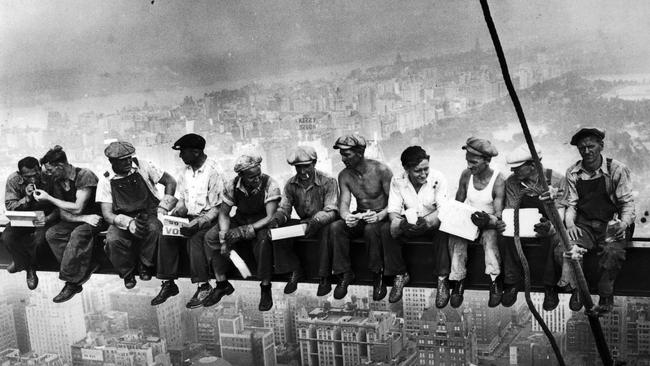The story behind this famous photograph
THEY’RE perched 69 floors above ground, but these men have no harness, no safety net, and no security at all. Why?

ELEVEN men are perched 256 metres above the ground. There are no harnesses and no safety net. One false move means certain death.
It’s one of the most iconic pictures to come out of the Great Depression.
The workers — mostly immigrants desperate to feed their families — were enjoying lunch before getting back to constructing 30 Rockefeller Centre in the middle of Manhattan.
While the scene was no doubt dangerous, in 1932 workers were just thankful to have a job, with unemployment sitting at a huge 24 per cent.
Governments around the world invested in construction in the hope of getting people jobs, but many of the roles created were far from safe.
But that was the era; enduring the Great Depression of the time meant taking risks to feed the kids. Workers were desperate for jobs — and the Rockefeller afforded that opportunity. This was the American dream. Immigration and industrialisation were “exploding”.
“The pay was good. The thing was, you had to be willing to die,” John Rasenberger, author of High Steel: The Daring Men Who Built the World’s Greatest Skyline, said.
Few would have thought that fateful day that more than eighty years on, their story would become legend. The spirit of a city.
Yet the identities of the men are for the most part unknown. Speculation among some Irish families is rife, but few have been formally identified.
Corbis, the company which owns the iconic image, believe for “certain, they were part of a new generation of Americans, descendants of late 19th century European migrants”.
One man though, has been able to successfully identify two.
The man third from the right is Joe Curtis, spotted from several other photographs taken on the day. Along with Curtis, that’s Joseph Eckner third from the left.
“Because the work records don’t exist, it is very hard to prove that they were there,” Seán Ó Cualáin, who produced the 2012 documentary Men at Lunch, told the Smithsonian.
“We cross referenced different photographs from the Rockefeller Center archives. They found another photograph of two of the men from the beam, and luckily, on the back of that one, their names were marked, as Joseph Eckner and Joe Curtis.”
But the men did not reap any reward when the New York Herald Tribune published the photograph on October 2, 1932.
“While New York’s thousands rush to crowded restaurants and congested lunch counters for their noon day lunch, these intrepid steel workers atop the 70 story RCA building in Rockefeller Center get all the air and freedom they want by lunching on a steel beam with a sheer drop of over 800 feet to the street level,” read the picture caption.
“The RCA building is the largest office building in terms of office space in the world.”
Few clues are given of the photographer’s identity, they were never credited until the turn of the 21st Century. Three names have since been thrown to the wind — Charles C. Ebbet, Thomas Kelley and William Leftwich — but it is unclear who took the iconic shot.
Whatever the case, whoever it was, they succeeded to show the world the might of man’s accomplishments.
Just don’t look down.
— youngma@news.com.au



